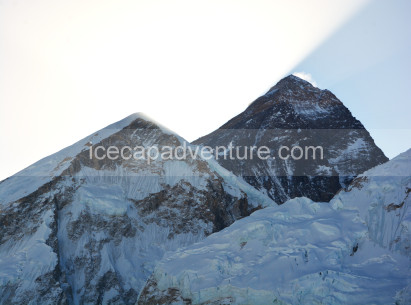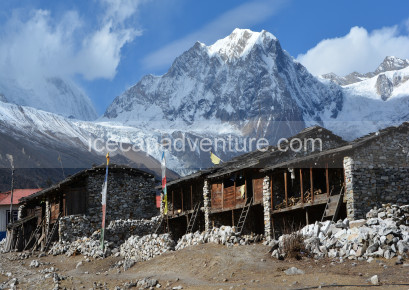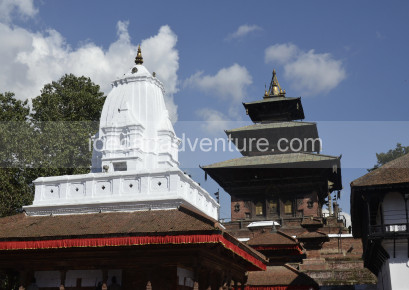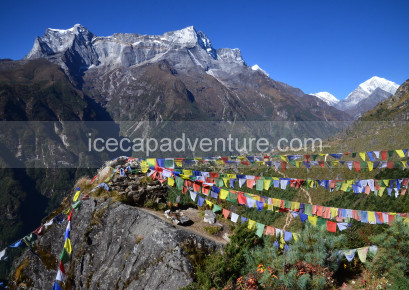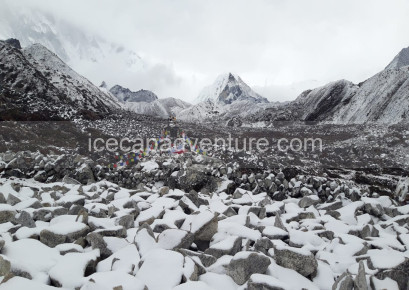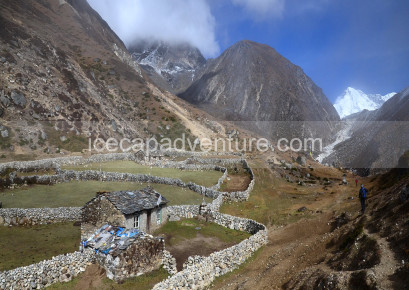.png)
.png)
.png)
.png)
.png)
.png)
.png)
.png)
The Everest Base Camp via Two High Passes Trek is a thrilling high-altitude adventure in the Khumbu region of Nepal, combining the classic Everest Base Camp experience with the challenge of crossing two major Himalayan passes: Cho La Pass (5,420m) and Renjo La Pass (5,360m). This trek takes you through breathtaking landscapes, including glacial valleys, pristine lakes, and dramatic peaks such as Mount Everest (8,848m), Lhotse (8,516m), Nuptse (7,861m), Ama Dablam (6,812m), and Cho Oyu (8,188m). Along the route, trekkers traverse Sherpa villages, Buddhist monasteries, and the Everest National Park, combining adventure with cultural immersion.
Duration & Difficulty
This trek typically lasts 18–22 days depending on the itinerary and acclimatization schedule. Classified as strenuous, it demands excellent physical fitness and prior trekking experience due to high passes, steep ascents, and rugged terrain.
Best Time to Trek
The best trekking seasons are autumn (September–November), with clear skies and stable weather, and spring (March–May), when rhododendrons bloom and temperatures are moderate. Monsoon season (June–August) brings heavy rainfall, while winter treks are cold and snowy.
Permits & Regulations
Trekking in the Everest region requires a Sagarmatha National Park Permit, a Khumbu Pasang Lhamu Rural Municipality Permit, and a TIMS Card (Trekkers’ Information Management System). These permits ensure regulated trekking and help preserve the fragile Himalayan ecosystem.
Accommodation & Food
Accommodation is provided in tea houses or lodges, offering basic but comfortable facilities. Meals are served on full board (breakfast, lunch, dinner, and tea/coffee). Lodges typically provide Nepali and limited Western food options. On camping treks, meals are freshly prepared by the trekking cook, and a day pack is carried for essentials.
Altitude & Safety
With high points like Cho La Pass (5,420m) and Renjo La Pass (5,360m), altitude sickness is a potential concern. Proper acclimatization, hydration, and rest are essential. Travel insurance covering high-altitude trekking and helicopter evacuation is strongly recommended.
Responsible Travel
The trek follows eco-friendly practices, minimizing waste, avoiding wood fires, and supporting local communities. Trekking staff are provided with proper gear and support to ensure safety and fair treatment.
Flights & Transfers
Trek usually begins with a flight from Kathmandu to Lukla, the gateway to the Everest region. Transfers between villages are on foot, with accommodations arranged in tea houses. Return flights from Lukla to Kathmandu complete the trek.
Trip Highlights:
-
Everest Base Camp: Stand at the foot of the world’s highest peak and witness breathtaking Himalayan vistas.
-
Cho La Pass & Renjo La Pass: Experience the thrill of crossing two challenging high-altitude passes.
-
Gokyo Lakes: Explore the pristine turquoise lakes of the Gokyo Valley.
-
Panoramic Mountain Views: Spectacular views of Everest, Lhotse, Nuptse, Ama Dablam, Cho Oyu, and other iconic peaks.
-
Sherpa Culture: Visit remote villages, monasteries, and experience traditional Sherpa hospitality.
-
Less Crowded Routes: Compared to the classic EBC trek, this route offers solitude and serenity in the high Himalayas.
-
Photography Opportunities: Glacial rivers, turquoise lakes, high passes, and snow-capped peaks provide endless photo moments.
1
Upon arrival at Tribhuvan International Airport, Kathmandu, our team will warmly welcome you with a traditional Nepali flower garland, marking the beginning of your extraordinary Himalayan adventure. You will then be transferred to Hotel, a short drive of approximately 30 minutes during the day or 20 minutes at night.
At the hotel, enjoy welcome drinks and biscuits, followed by the settlement of your rooms. Once settled, join us for a briefing session in the lobby or meeting hall, where our expert guides will introduce the trekking program, itinerary, and important details about the journey ahead. This is also the perfect opportunity to meet your trekking guide, review your trekking equipment, and receive information about the domestic flight schedule to Lukla, the starting point of your trek.
Note: If you arrive in Kathmandu at night, all briefings and equipment checks will be scheduled for the following day after breakfast.
.png)
.png)
.png)
.png)
2
After breakfast at your hotel, you will have the opportunity to explore some of Kathmandu’s iconic cultural heritage sites, such as Kathmandu Durbar Square, Swayambhunath (Monkey Temple), or Boudhanath Stupa, offering a fascinating glimpse into Nepal’s rich history and spiritual traditions.
In the afternoon, our team will assist you in checking your trekking gear and ensuring you have all the necessary equipment for the journey ahead. If any items need to be purchased or rented, we will guide you to the best shops in Thamel, where high-quality trekking gear is available at reasonable prices.
In the evening, your trekking guide will conduct a final briefing, covering the trek route, safety precautions, and expected weather conditions. This preparation ensures you are fully ready for the adventure that begins tomorrow. Overnight stay at a hotel in Kathmandu.
.png)
.png)
.png)
.png)
3
After an early breakfast, you will take a scenic domestic flight from Kathmandu to Lukla, the gateway to the Everest region. The flight, approximately 35 minutes, offers stunning aerial views of the Himalayan peaks, rolling hills, and the Dudh Koshi River valley—a breathtaking introduction to your high-altitude adventure.
Upon arrival in Lukla, you will meet your trekking team, including guides and porters, and begin your trek towards Phakding (2,640 m). The trail follows the Dudh Koshi River, passing through charming villages, traditional monasteries, and lush forests. This first day of trekking is relatively easy, allowing you to acclimatize gently while enjoying your first panoramic views of the mountains. Overnight stay at a teahouse in Phakding, surrounded by the serene Himalayan landscape.
Highlights of the Day:
-
Scenic mountain flight from Kathmandu to Lukla with Himalayan panoramas.
-
Walking along the Dudh Koshi River with suspension bridges and prayer flags.
-
Passing through traditional Sherpa villages and pine forests.
-
Gentle trekking to Phakding (2,640 m), ideal for the first day of acclimatization.
-
Arrival at a cozy teahouse for rest, meals, and overnight stay.
.png)
.png)
.png)
.png)
4
After breakfast at Phakding (2,610 m), your trek continues along the Dudh Koshi River, crossing traditional suspension bridges and walking through scenic Sherpa villages such as Monjo (2,835 m). The trail gradually ascends through pine forests and offers stunning views of peaks like Thamserku (6,623 m) and Kongde Ri (6,187 m). As you approach Namche Bazaar (3,440 m), the bustling trading hub of the Khumbu region, you will be immersed in vibrant Sherpa culture, traditional shops, and lively markets. This moderately challenging ascent is an essential acclimatization step, preparing your body for higher altitudes. Upon arrival, you may explore Namche, visit local cafes, or take a short hike to the Namche viewpoint (3,550 m) for your first close-up views of Mount Everest (8,848 m) and surrounding peaks. Overnight stay at a teahouse in Namche Bazaar.
Highlights:
-
Trek along the scenic Dudh Koshi River with suspension bridges and forests
-
Walk through traditional Sherpa villages, including Monjo (2,835 m).
-
Stunning views of Himalayan peaks such as Thamserku (6,623m) and Kongde Ri (6,187m)
-
Arrival at Namche Bazaar (3,440m), the cultural and trading hub of the Khumbu region
-
Explore local markets, cafes, and Sherpa culture.
.png)
.png)
.png)
.png)
5
After breakfast in Namche Bazaar (3,440 m), the trek continues for approximately 3–4 hours towards Thame (3,820 m), a traditional Sherpa village rich in culture and history. The trail gradually ascends through forests of pine and rhododendron, offering beautiful views of surrounding peaks like Ama Dablam (6,812 m) and Thamserku (6,623 m). Along the way, pass small settlements, mani walls, and prayer flags that highlight the spiritual atmosphere of the Khumbu region. Thame is renowned for its ancient monasteries, traditional Sherpa homes, and friendly locals, making it an ideal place to rest and further acclimatize before ascending higher passes. Overnight stay at a teahouse in Thame.
Highlights :–
-
Trek from Namche Bazaar (3,440m) to Thame (3,820m)
-
Scenic views of Ama Dablam (6,812m) and Thamserku (6,623m)
-
Walk through pine forests, rhododendron trails, and Sherpa settlements
-
Experience Sherpa culture, ancient monasteries, and prayer-flag lined paths
-
Short trekking day for acclimatization before higher passes
.png)
.png)
.png)
.png)
6
After breakfast in Thame (3,820m), the trek continues for approximately 5–6 hours towards Lungden (4,350m). The trail ascends gently, offering a choice of paths: the left side follows the river valley toward Tibet, while the right side leads directly to Lungden and eventually toward Raejola Pass. Trekkers will pass through alpine meadows, scattered stone paths, and small Sherpa settlements, experiencing the serene beauty of the Khumbu region. Along the way, enjoy views of surrounding Himalayan peaks, and witness traditional mani walls and colorful prayer flags that highlight the spiritual atmosphere. Lungden is a quiet village ideal for rest and acclimatization before the challenging high passes ahead. Overnight stay at a teahouse in Lungden.
Highlights:
-
Trek through alpine meadows and traditional Sherpa villages
-
Trail splits: left toward Tibet boarder, right toward Lungden and Raejola Pass
-
Walk along mani walls and prayer-flag lined trails
-
Rest and acclimatization at a quiet village before high passes
.png)
.png)
.png)
.png)
7
After breakfast in Lungden, the trek begins the challenging ascent towards Renjo La Pass (5,360 m), one of the two high passes on this route to Everest Base Camp. The trail gradually climbs through rocky paths, alpine meadows, and glacial moraine, offering breathtaking views of Mount Everest (8,848 m), Cho Oyu (8,188 m), Lhotse (8,516 m), Nuptse (7,861 m), Pumori (7,161 m), Gyachung Kang (7,952 m), and surrounding peaks. Crossing Renjo La Pass is a rewarding experience, providing panoramic vistas of the Gokyo Valley and the majestic Everest region, perfect for photography and reflection. After descending from the pass, continue to Gokyo village (4,750 m), a serene settlement located beside Gokyo Lake, surrounded by snow-capped mountains. This day is physically demanding but offers some of the most spectacular scenery of the trek. Overnight stay at a teahouse in Gokyo.
Highlights:
-
Ascend to Renjo La Pass (5,360m), a major high pass of the Everest region
-
Panoramic views of Mount Everest, Cho Oyu, Lhotse, Nuptse, Pumori, and Gyachung Kang
-
Trek through alpine meadows, rocky paths, and glacial moraine
-
Descend to Gokyo village (4,750m) beside the stunning Gokyo Lake
-
Challenging yet rewarding day with some of the most spectacular Himalayan scenery
.png)
.png)
.png)
.png)
8
After breakfast in Gokyo (4,750 m), you will embark on a short but steep hike to Gokyo Ri (5,360 m), one of the most iconic viewpoints in the Everest region. The climb offers panoramic vistas of the Everest massif, including Mount Everest (8,848 m), Cho Oyu (8,188 m), Lhotse (8,516 m), Makalu (8,463 m), Nuptse (7,861 m), and Ama Dablam (6,812 m). From the summit, enjoy a breathtaking 360-degree view of the surrounding Himalayan peaks, glacial lakes, and the Gokyo valley, making it one of the most photogenic spots on the trek. After soaking in the views and taking photographs, descend back to Gokyo village for a relaxing afternoon, allowing your body to acclimatize for the challenging high passes ahead. Overnight stay at a teahouse in Gokyo.
Highlights:
-
Short but steep hike to Gokyo Ri (5,360m)
-
Panoramic views of Mount Everest, Cho Oyu, Lhotse, Makalu, Nuptse, and Ama Dablam
-
Stunning vistas of Gokyo Lakes and the surrounding Himalayan valley
-
Opportunity for photography and reflection at one of the most scenic points in the region
-
Afternoon descent for rest and acclimatization
.png)
.png)
.png)
.png)
9
After breakfast in Gokyo (4,750m), the trek continues for approximately 3–4 hours to Thangnak (4,700m), a serene settlement located near the base of Cho La Pass. The trail gradually ascends along glacial moraine and alpine meadows, passing smaller lakes, mani walls, and prayer-flag adorned trails. Along the way, enjoy panoramic views of Cho Oyu (8,188m), Taboche (6,501m), and other surrounding peaks, while experiencing the peaceful atmosphere of the high Himalayas. Thangnak serves as a perfect acclimatization stop, preparing trekkers for the challenging Cho La Pass crossing the next day. Overnight stay at a teahouse in Thangnak.
Highlights:
-
Trek from Gokyo (4,750m) to Thangnak (4,700m) along glacial moraine
-
Panoramic views of Cho Oyu (8,188m), Taboche (6,501m), and surrounding peaks
-
Trails adorned with mani walls and prayer flags
-
Serene alpine scenery for rest and acclimatization before Cho La Pass
-
Short trekking day to prepare for the high pass crossing
.png)
.png)
.png)
.png)
10
After breakfast in Thangnak (4,700m), you will begin the challenging ascent to Cho La Pass (5,420m), one of the two high passes on this trek. The climb is steep and demanding, traversing rocky paths, snowfields, and glacial moraine, offering spectacular views of Cho Oyu (8,188m), Taboche (6,501m), Cholatse (6,440m), and other surrounding peaks. Reaching the summit of Cho La Pass is a rewarding experience, providing panoramic vistas of the Everest region and the Khumbu glaciers. After celebrating the achievement and capturing unforgettable photos, descend carefully to Dzongla (4,830m), a quiet settlement ideal for rest and acclimatization. This day is physically demanding but highly rewarding, with some of the most dramatic high-altitude scenery of the trek. Overnight stay at a teahouse in Dzongla.
Highlights:
-
Challenging climb to Cho La Pass (5,420m), a major high pass of the Everest region
-
Panoramic views of Cho Oyu, Taboche, Cholatse, and surrounding peaks
-
Trek across rocky trails, snowfields, and glacial moraine
-
Descent to Dzongla (4,830m) for rest and acclimatization
-
Rewarding high-altitude experience with dramatic Himalayan scenery
.png)
.png)
.png)
.png)
11
After breakfast in Dzongla the trek continues for approximately 3 - 4 hours towards Lobuche (4,910m). The trail ascends gradually along rocky paths and glacial moraine, offering breathtaking views of the Khumbu Glacier, Nuptse (7,861m), Pumori (7,161m), and other surrounding Himalayan peaks. Along the way, trekkers pass small high-altitude settlements and prayer-flag lined trails, immersing in the serene and spiritual atmosphere of the region. Lobuche is a key stop before the final ascent to Everest Base Camp, providing opportunities to rest, acclimatize, and enjoy panoramic mountain vistas. Overnight stay at a teahouse in Lobuche.
Highlights:
-
Trek from Dzongla (4,830m) to Lobuche (4,910m)
-
Stunning views of Khumbu Glacier, Nuptse, Pumori, and surrounding peaks
-
Trek through high-altitude settlements and prayer-flag adorned trails
-
Preparation for the final ascent to Everest Base Camp
-
Immersive experience of the serene and spiritual Himalayan environment
.png)
.png)
.png)
.png)
12
After an early breakfast in Lobuche, the trek continues to the legendary Everest Base Camp (5,364m), following a trail along rocky moraine and glacial paths. The journey is challenging but immensely rewarding, offering close-up views of Nuptse (7,861m), Lhotse (8,516m), and the Khumbu Icefall. At Base Camp, take time to soak in the atmosphere of the world’s highest peak, capture memorable photographs, and celebrate reaching this iconic destination. After enjoying the views, descend to Gorak Shep (5,164m), a small settlement that serves as the last stop before the trek back. This day combines high-altitude trekking with unforgettable Himalayan scenery, making it the highlight of the entire journey. Overnight stay at a teahouse in Gorak Shep.
Highlights:
-
Trek from Lobuche (4,910m) to Everest Base Camp (5,364m)
-
Close-up views of Nuptse, Lhotse, Khumbu Icefall, and surrounding peaks
-
Experience the world-famous Everest Base Camp
-
Descend to Gorak Shep (5,164m) for overnight stay
-
Unforgettable high-altitude Himalayan scenery and adventure
.png)
.png)
.png)
.png)
13
After an early breakfast in Gorak Shep you will make a pre-dawn ascent to Kala Patthar (5,545m), the iconic viewpoint of the Everest region. The climb is moderately steep but short, offering breathtaking sunrise views of Mount Everest (8,848m), Lhotse (8,516m), Nuptse (7,861m), Pumori (7,161m), and surrounding Himalayan peaks. From the summit, enjoy a 360-degree panorama of the Khumbu Glacier, Everest Base Camp, and the high Himalayas, making it one of the most photogenic and memorable moments of the trek. After capturing the spectacular scenery, descend to Gorak Shep for breakfast, then continue trekking down to Dingboche (4,410m) for overnight rest. This day combines epic Himalayan vistas with essential descent for acclimatization, preparing you for the return journey through the high passes. Overnight stay at a teahouse in Dingboche.
Highlights:
-
Early morning climb to Kala Patthar (5,545m) for sunrise views
-
Panoramic vistas of Mount Everest, Lhotse, Nuptse, Pumori, and Khumbu Glacier
-
Capture memorable photographs of the world’s highest peaks
-
Descend to Dingboche (4,410m) for rest and acclimatization
-
A day combining high-altitude adventure and epic Himalayan scenery
.png)
.png)
.png)
.png)
14
After breakfast in Dingboche the trek begins the gradual descent towards Namche Bazaar (3,440m). The trail passes through alpine meadows, rhododendron forests, and charming Sherpa villages, offering a more relaxed trekking pace after the high-altitude challenges. Along the way, enjoy stunning views of Ama Dablam (6,812m), Thamserku (6,623m), and other surrounding peaks, while passing traditional manis, prayer flags, and monasteries, allowing for continued cultural immersion. This descent provides an excellent opportunity to rest, reflect on the journey, and appreciate the Himalayan landscapes. Upon arrival, explore Namche Bazaar, visit local shops, or enjoy tea at a mountain café. Overnight stay at a teahouse in Namche Bazaar.
Highlights:
-
Descend from Dingboche (4,410m) to Namche Bazaar (3,440m)
-
Trek through alpine meadows, rhododendron forests, and Sherpa villages
-
Views of Ama Dablam, Thamserku, and surrounding Himalayan peaks
-
Experience Sherpa culture, prayer flags, and monasteries
-
Relaxed descent to rest and reflect on the high-altitude trek
.png)
.png)
.png)
.png)
15
After breakfast in Namche Bazaar (3,440m), the trek begins the descent through Sherpa villages, rhododendron forests, and suspension bridges, retracing the trail back to Lukla (2,840m). The journey is more relaxed, allowing trekkers to enjoy the scenic valleys, rivers, and traditional villages one last time. Along the way, pause to admire the panoramic Himalayan views, interact with local communities, and soak in the serene high-altitude landscapes. Upon arrival in Lukla, check into your teahouse and rest, reflecting on the incredible journey through the Everest region. Overnight stay at a teahouse in Lukla.
Highlights:
-
Descend from Namche Bazaar (3,440m) to Lukla (2,840m)
-
Trek through Sherpa villages, rhododendron forests, and suspension bridges
-
Enjoy scenic views of valleys, rivers, and surrounding Himalayan peaks
-
Opportunities to interact with local communities and experience Sherpa culture
-
Relax and reflect on the high-altitude trek before departure
.png)
.png)
.png)
.png)
16
After breakfast in Lukla, you will take a domestic flight back to Kathmandu (approx. 35 minutes). The short flight offers breathtaking aerial views of the Himalayan peaks, deep valleys, and winding rivers—a final chance to soak in the grandeur of the Everest region from above. Upon arrival in Kathmandu, you will be transferred to your hotel to relax and freshen up. This marks the successful completion of the Everest Base Camp via 2 High Passes trek, a truly unforgettable high-altitude adventure. The evening can be spent exploring the city, shopping for souvenirs, or enjoying a celebratory farewell dinner. Overnight stay at a hotel in Kathmandu.
Highlights:
-
Domestic flight from Lukla (2,840m) to Kathmandu
-
Stunning aerial views of Himalayan peaks, valleys, and rivers
-
Transfer to your hotel in Kathmandu for rest and relaxation
-
Celebrate the completion of an unforgettable high-altitude trek
-
Optional exploration or farewell dinner in Kathmandu
.png)
.png)
.png)
.png)
17
After completing your 2 High Passes Everest Base Camp trek and returning to Kathmandu, today is reserved for rest, relaxation, and leisure activities. Following breakfast at your hotel, you can take a stroll around Thamel, the bustling tourist hub, where you will find trekking gear, handicrafts, pashmina shawls, traditional Nepali clothing, souvenirs, and artwork. You may also visit cultural and spiritual sites such as Boudhanath Stupa, Swayambhunath (Monkey Temple), or Patan Durbar Square, experiencing the rich heritage of Kathmandu Valley. This day provides the perfect opportunity to recover from your trek, shop for unique souvenirs, and immerse yourself in local culture. In the evening, enjoy an optional traditional Nepali cultural program with music and dance for a memorable farewell.
Highlights:
-
Leisure day for rest and recovery after the trek
-
Shopping in Thamel for souvenirs, handicrafts, and trekking gear
-
Visit UNESCO World Heritage Sites: Boudhanath, Swayambhunath, or Patan Durbar Square
-
Enjoy a traditional Nepali cultural program with music and dance
-
Free time to explore cafés, local markets, and city streets
.png)
.png)
.png)
.png)
18
Today marks the conclusion of your unforgettable journey in Nepal. After breakfast at your hotel in Kathmandu, you will be transferred to Tribhuvan International Airport for your onward flight to your next destination. Depending on your flight schedule, you may have a final opportunity to explore Kathmandu, take photographs, or purchase last-minute souvenirs. As you bid farewell to the Himalayas and the rich culture of Nepal, take with you the memories of your 2 High Passes Everest Base Camp trek, the stunning landscapes, and the warm hospitality of the Nepali people.
Highlights:
-
Transfer to Tribhuvan International Airport for your departure
-
Opportunity for last-minute shopping or sightseeing in Kathmandu
-
Farewell to the Himalayan region and Nepali culture
-
Take home unforgettable memories from the trek
.png)
.png)

Didn’t find what you were looking for?
So why not plan your own trip. It takes only 2 minutes.- Airport Pick up and transfers to hotel. Full board meals during the trekking such as : Breakfast, Lunch and D
- All hotel accommodation in Kathmandu, Lukla and Trekking.
- Full board meals during the trekking such as : Breakfast, Lunch and Dinner.
- Properly 3 times tea and coffee whatever hot drinks are available.
- Climb up to Kalapattar and View of Khumbu Himalayan range
- Full support crew with 1 porter for every 2 trekkers.
- Experience professional guide.
- Full insurance for guide and porter.
- Domestic flight ticket from Kathmandu to Lukla to Kathmandu.
- Trekking Maps and Notebooks.
- All transportation with AC deluxe from the starting to ending points of the trip.
- National park entry fee and TIMS card or trekking permit whatever needed.
- Down Sleeping bag (-20), must be returned after completing the trek.
- First Aid Kit for staff and Oxygen for in case.
- Trekking achievement certificate after completed the Treks.
- All international flight tickets, Travel insurance and Nepal entry visa fees.
- Lunch and dinner in Kathmandu.
- All hard drinks such as : Mineral water, whisky, rum, cola, fanta, etc.
- Extra entrance fees such as Museum, Monastry, Temple, Boating, etc.
- Personal equipment and medical insurance.
- Personal equipment and medical insurance.
- Personal expenses like hot shower and battery charge / wifi.
- Extra night Hotel in Kathmandu if arriving late or early departure than scheduled itinerary.
- Any emergency rescue evacuation and extra cost offering from unfavorable circumstance such as weather bad.
- Personal tips for trekking staff.


✅ Clothing
-
Base Layers (Thermal Tops & Bottoms)
-
Trekking Shirts (Long & Short Sleeves)
-
Fleece Jacket / Warm Mid-layer – For insulation.
-
Down Jacket – Essential for nights above 3,500m.
-
Waterproof & Windproof Jacket (with hood).
-
Trekking Pants (lightweight, quick-drying).
-
Warm Trekking Pants (for high altitude).
-
Waterproof Pants (for rain/snow).
-
Underwear – Comfortable, quick-dry.
-
Sports Bras (for women).
✅ Head & Hand Wear
-
Warm Hat / Beanie and Sun Hat / Cap.
-
Buff / Neck Gaiter / Scarf.
-
Sunglasses and Gloves 2 pairs
✅ Footwear
-
Trekking Boots – Sturdy, waterproof, broken-in.
-
Lightweight Shoes / Sandals – For camp/teahouse.
-
Warm Trekking Socks – At least 4–5 pairs.
✅ Sleeping & Bags
-
Sleeping Bag (Down -15°C) and Liner.
-
Duffel Bag (carried by porter).
-
Daypack (30–40L) – For personal items.
-
Rain Cover for Backpack.
✅ Trekking Gear
-
Trekking Poles & Gaiters – For snow or muddy.
-
Headlamp (with extra batteries).
-
Water Bottles (2–3 liters) and Water Purifications.
-
Personal First Aid Kit
-
Snacks / Energy Bars / Dry Fruits.
✅ Accessories & Personal Items
-
Sunscreen (SPF 30–50) and Lip Balm with SPF.
-
Toiletries and Hand Sanitizer.
-
Towel (quick-dry) and Toilet Paper
-
Camera / Power Bank / Solar Charger.
✅ Documents & Money
-
Valid Passport and Visa.
-
Travel Insurance (cover high-altitude & helicopter rescue).
-
Cash (Nepali Rupees) – For personal expenses.
Good to Know – Everest Base Camp via 2 High Passes Trekking
-
Best Seasons to Trek:
The optimal time for the Everest Base Camp (EBC) trek via 2 high passes (typically Cho La Pass and Renjo La Pass) is during spring (March–May) and autumn (September–November). These seasons offer clear skies, stable weather, and excellent visibility of the Himalayan peaks. Winter is cold with snow covering the passes, while monsoon brings heavy rainfall, slippery trails, and higher risk of landslides. -
Altitude Awareness:
This trek reaches a maximum altitude of 5,420 meters at Cho La Pass. It is a high-altitude trek, and proper acclimatization is critical to prevent acute mountain sickness (AMS). Gradual ascent, hydration, and rest days at villages like Namche Bazaar, Gokyo, or Dingboche are strongly recommended. -
Physical Fitness:
The trek is challenging to strenuous, suitable for trekkers with good fitness levels and prior trekking experience. Daily trekking can last 6–8 hours, including steep climbs, glacier trails, and rocky passes. -
Permits Required:
Trekkers need a Sagarmatha National Park Permit and a TIMS (Trekkers’ Information Management System) card, obtainable in Kathmandu or at Monjo park entrance. -
Accommodation and Meals:
Teahouses along the trail provide basic rooms with shared bathrooms. Meals include dal bhat, noodles, soups, pasta, pancakes, and tea/coffee. Food options are more limited and expensive at higher elevations. -
Drinking Water:
Bottled water is available in villages, but using a reusable bottle with purification tablets or filters is recommended. Boiled water is available in teahouses for a small fee, especially at higher camps. -
Packing and Gears:
Essential items include layered clothing, insulated jacket, trekking boots, crampons for icy sections, trekking poles, gloves, hat, rain gear, headlamp, sunglasses, sunscreen, power bank, first aid kit, and a sleeping bag suitable for cold nights. Proper gear for snow and high passes is critical. -
Transportation and Route:
The trek usually starts with a flight from Kathmandu to Lukla, followed by trekking through Namche Bazaar, Gokyo, Dzongla, Cho La Pass, and Renjo La Pass before reaching Everest Base Camp. The route passes glaciers, high alpine lakes, and Sherpa villages, providing both adventure and cultural experiences. -
Travel Insurance:
Comprehensive high-altitude trekking insurance is highly recommended, covering medical emergencies, evacuation, and trekking at high passes. -
Connectivity and Charging:
Mobile signals are available in larger villages such as Namche Bazaar, Gokyo, and Dingboche, but are limited near high passes. Most lodges offer charging facilities for a small fee; carrying a power bank is essential. -
Highlight Experience:
This trek combines Everest Base Camp adventure with the thrill of crossing two high Himalayan passes. Trekkers enjoy stunning panoramas of Everest, Lhotse, Makalu, Cho Oyu, Ama Dablam, plus the spectacular turquoise Gokyo Lakes, glaciers, and remote high-altitude landscapes. It’s one of the most rewarding and challenging treks in Nepal.

